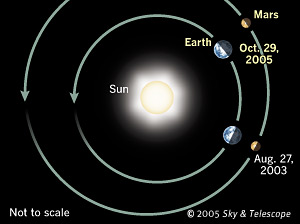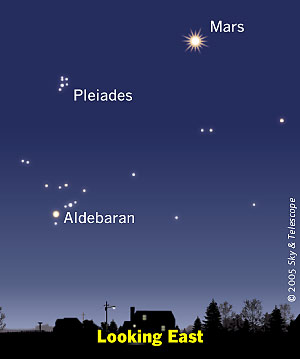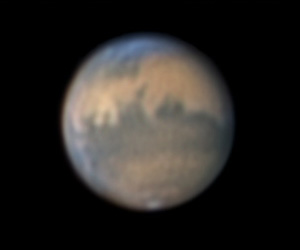October 18, 2005
Contacts:
Alan MacRobert, Senior Editor
855-638-5388 x151, [email protected]
Marcy McCreary, VP Mktg. & Business Dev.
855-638-5388 x143, [email protected]
Note to Editors/Producers: This release is accompanied by publication-quality graphics; see details below.
Look east late these evenings and you'll see a big, fiery yellow "star" shining much brighter than any other. This is the planet Mars, and it's passing unusually close to Earth during late October and early November 2005. Anyone can see it — no matter how little you know about the stars or how badly light-polluted your sky may be.
During mid- to late October, look for Mars glaring low in the east after 8 p.m. local daylight-saving time. In November, it's there in view as early as 6 p.m. standard time. Later in the evening, Mars climbs higher into better view and shifts over to the southeast. There's nothing else nearly as bright that you can confuse it with.
Mars will be its closest to Earth on the night of October 29–30, passing 43.1 million miles (69.4 million kilometers) from our planet around 11:25 p.m. on the 29th Eastern Daylight Time. However, Mars will look just about as big and brilliant for a couple of weeks before and after that date.
Mars is at opposition (opposite the Sun in our sky) on November 7th. This means it rises at sunset, is up all night, and sets at sunrise.
This is the nearest that Mars has come since its record-breaking close approach in August 2003. At that time it passed by at a distance of only 34.7 million miles (55.8 million kilometers), the closest it had come in nearly 60,000 years. But for amateur telescope users, now is still a very special time. The planet will reach an apparent diameter of 20.2 arcseconds (the angular size of a penny seen at a distance of 620 feet), offering an usually detailed view of its surface. That compares with 25.1 arcseconds in August 2003 (the angular size of a penny at 500 feet), and only 15.9 arcseconds at Mars's next swing-by, in December 2007 (a penny at 800 feet).
In fact, not until the summer of 2018 will Mars again come as close to Earth as it is right now (this statement remains true until mid-November).
Moreover, this year skywatchers at the latitudes of North America and Europe have a big advantage they didn't have in 2003. That year Mars was far south in the sky and never got very high for telescope users at mid-northern latitudes. But this time Mars is farther north and rises higher during the night, affording a sharper, cleaner view in a telescope through Earth's blurry atmosphere.
Telescope Tips
Good as this fall's showing is, surface details on Mars are always a pretty tough target in a telescope. To begin with, Mars is only about half the size of Earth. Even at its closest, under high magnification it will appear as only a surprisingly small, bright ball with some subtle dark markings, possible white clouds around its edges, and perhaps a tiny remnant of the white South Polar Cap shrunken in the warmth of the Martian summer. The brightest yellow areas are deserts covered by fine, windblown dust. The darker markings are terrain displaying more areas of bare rock or darker sand and dust. Mars rotates every 24½ hours, so you can see it turning in just an hour or two of watching.
To see much detail on Mars, several things all have to be working in your favor. You’ll need at least a moderately large telescope with high-quality optics. (For the lowdown on how to select a telescope wisely, see Sky & Telescope's article "Choosing Your First Telescope".) And you’ll need to wait until Mars rises high in the sky, well above the thick, murky layers of Earth's atmosphere near the horizon. Moreover, the atmospheric "seeing" must be good. This is the astronomer’s term for the constant fuzzing and shimmering of highly magnified telescopic images due to the tiny heat waves that are always rippling through the atmosphere. The seeing changes from night to night and sometimes from moment to moment.
More about Mars and its unusual close approach appears in the September issue of Sky & Telescope and in the November/December 2005 issue of Night Sky, our new bimonthly magazine for beginners.
Sky & Telescope is pleased to make the following publication-quality graphics available to the news media. Permission is granted for one-time, nonexclusive use in print and broadcast media, as long as appropriate credits (as noted in each caption) are included. Web publication must include a link to SkyandTelescope.com.

The orbits of Earth and Mars bring these neighboring worlds close together about every two years. For skygazers, the best meetings occur when Mars is near perihelion, the point of its lopsided orbit that's closest to the Sun, as was the case in 2003. This year's pairing, while not quite as good, is still very favorable and will be the best until 2018. Click on the image to download a publication-quality version (95-kilobyte JPEG) by anonymous FTP.
Sky & Telescope illustration.

After night falls, you'll find Mars rising in the east. Here's the scene near 9 p.m. daylight-saving time in late October 2005 and earlier in the evening in November. Your telescopic view of Mars will likely be better if you wait a couple more hours until the planet is higher above the atmospheric haze and turbulence near the horizon. Click on the image to download a publication-quality version (96-kilobyte JPEG) by anonymous FTP.
Sky & Telescope illustration.

Mars on October 17–18, 2005, as recorded by Sky & Telescope assistant editor Sean Walker. Note the dark markings across the disk, the tiny remains of the South Polar Cap at the bottom, and the hazy, bluish North Polar Hood of clouds at the top. Walker used a webcam on a 7-inch telescope to create this view. Click on the image to download a publication-quality version (59-kilobyte JPEG) by anonymous FTP.
Photo by Sean Walker, courtesy Sky & Telescope.
Sky Publishing Corp. was founded in 1941 by Charles A. Federer Jr. and Helen Spence Federer, the original editors of Sky & Telescope magazine. The company's headquarters are in Cambridge, Massachusetts, near the Harvard-Smithsonian Center for Astrophysics. In addition to Sky & Telescope and SkyandTelescope.com, the company publishes Night Sky magazine (a bimonthly for beginners with a Web site at NightSkyMag.com), two annuals (Beautiful Universe and SkyWatch), as well as books, star atlases, posters, prints, globes, and other fine astronomy products.
 0
0
Comments
You must be logged in to post a comment.